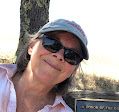
Five years have past; five summers with the length
Of five long winters! and again I hear
These waters, rolling from their mountain-springs
With a soft inland murmur.—Once again
Do I behold these steep and lofty cliffs,
That on a wild secluded scene impress
Thoughts of more deep seclusion; and connect
The landscape with the quiet of the sky.
--from “Tintern Abbey,” by William Wordsworth
Yes, we were playing hooky on Monday when Wordsworth came to mind. My husband and I had made the two-hour drive to Pike’s Peak State Park in northeast Iowa. We knew the fall colors would be past their peak. It wasn’t really the color that we craved, anyway; it was the rolling terrain. Geologist Jean Prior wrote that “if you had to divide Iowa into two different regions, one would be the extreme northeast corner and the other would be the rest of the state.”
Pike’s Peak State Park is named for the same Lieutenant Zebulon Pike as the 14,110-foot peak in Colorado. Iowa’s Pike’s Peak, just 500 feet above the Mississippi River floodplain, happens to be the tallest bluff overlooking the entire length of the Mississippi. We drove into the park around 3:00 p.m. It was 70 degrees and sunny, with plenty of time to hike before an early sunset.
Unlike Wordsworth's poem, more than five years had passed since our prior trip to Pike’s Peak. But we too heard the inland waters rolling -- at Bridal Veil Falls, where a creek flows over a dolomite shelf and drops to the Mississippi -- and we saw the steep cliffs that connected the landscape with “the quiet of the sky.”
Except it wasn’t entirely quiet as we walked. In between the swishing of the dry leaves, I heard echoes of a friendship. About twenty-six years ago we’d hiked here with our young son and our friends Deb and Craig and their son.
I heard the chipmunk chatter of our two little boys – both three, one blonde, one dark-haired – while we hiked the bluffs and gazed at the panoramic view of the Mississippi. And I heard laughter, because that’s what inevitably happens when we’re with Deb and Craig.
And so it was Monday that while we listened to the murmur of the water fall, I had the pleasure of the present and the past – and not only the past, but also the sense of “life and food for future years,” as Wordsworth puts it later in “Tintern”:
With many recognitions dim and faint,
And somewhat of a sad perplexity,
The picture of the mind revives again:
While here I stand, not only with the sense
Of present pleasure, but with pleasing thoughts
That in this moment there is life and food
For future years.
As if I’d stepped into a time machine, other memories of times with Deb and Craig rose up and carried me to other natural places – camping at Yellow River Forest and Backbone State Park, not far north of here; canoeing the Boundary Waters in northern Minnesota, a long way from here – and camping at Pine Lake State Park in central Iowa, three hours away.
After leaving Pike’s Peak we drove north into McGregor and wound up at Old Man River, a new brewery in town. We ordered beers and toasted to our long-time friendship with Craig, our master storyteller, and Deb, our generous friend with the tinkling laughter. All friendships ebb and flow, and ours is no exception; still, time has brought a depth to this good friendship that is not easily duplicated.
Here’s to nature, and to Deb and Craig, and to memories that have provided sustenance for yesterday, today, and tomorrow
Click Here to Read More..














